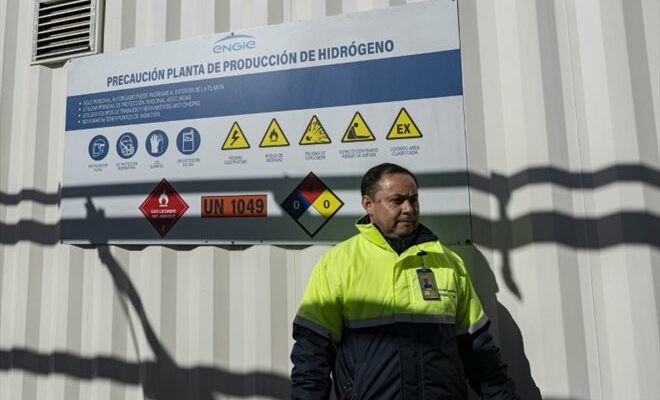A wind farm belonging to the French group Engie in the Antofagasta region, January 23, 2024 in Chile (AFP/Archives/RODRIGO ARANGUA)
Chile comes to Europe to present its energy strategy, looking for new investors in solar, wind and green hydrogen, in the hope of decarbonizing and developing its copper mines and its industry, dependent on coal and petrol.
“With the resources at its disposal, Chile is the only country in the world that can claim to become carbon neutral from 2040”, 10 years earlier than 2050, targeted by the Paris climate agreement, told the AFP Marcos Kulka, general director of H2Chile, the Chilean hydrogen association which brings together 102 public and private companies.
In the middle of a renegotiation of a proposed investment liberalization agreement between the European Union and Chile, Mr. Kulka came to Paris at the beginning of February, to the Hyvolution hydrogen fair.
Its aim is to explain to Europeans the strategy of the Chilean government, whose Minister of the Environment, Maisa Rojas Corradi, is a climatologist, former coordinator of the COP25 scientific committee.
Santiago, dependent on oil and imported coal, plans to replace its coal-fired power plants with renewable energy by 2040, used in turn to produce green hydrogen.
According to Mr. Kulka, a 24% share of the country’s CO2 emissions reduction “will come from hydrogen and its derivatives” to decarbonize heavy industry, notably copper mining, of which Chile is the largest. world’s leading exporter.
The country relies on solar power in the north, near the Atacama Desert and copper mining areas, and strong winds in the south, ideal for wind farms.
Despite its distance from Europe and North America, Chile wants to become “one of the most competitive green hydrogen producers in the world”. Because “more than 60% of the final cost of hydrogen comes from the price of the electricity used to produce it”.
– “25 gigawatts” –
The country “needs hydrogen to reduce CO2 emissions from ore trucks, for explosives used in mines, and for energy in maritime transport,” detailed Mr. Kulka. And “chemical manufacturers need it” to decarbonize their activities.

The Mejillones thermoelectric power station, in the Antofagasta region, on January 25, 2024 in Chile (AFP/RODRIGO ARANGUA)
The abundance and low costs of renewable energies attract many European manufacturers, such as the Austrian group Austria Energy, the French Engie, TotalEnergies and EDF, as well as German, Dutch and Norwegian investors, eager to import green hydrogen. in Europe.
For the moment, Chilean capacities for producing green hydrogen by electrolysis – the operation which separates hydrogen and oxygen molecules from water (H20) using electricity – remain low, barely ” 2 megawatts. The goal is to reach “25 gigawatts” in 2030, said Mr. Kulka, but the investment is gigantic.
Initially, the country is mainly focusing on the production of ammonia, which is used to make agricultural fertilizers, but which can serve as a de facto hydrogen carrier. It is up to the importing countries to “recrack” the NH3 molecule from ammonia when the boats arrive to obtain hydrogen.
– “Strategic for the EU” –
The International Energy Agency (IEA) has warned that only 7% of renewable energy projects worldwide to produce green hydrogen will see the light of day by 2030.
In Chile, 64 green hydrogen projects have been announced, of which “7 or 8 should receive a final investment decision before the end of the first half,” assured Mr. Kulka.

The first green hydrogen production plant in Latin America, during its inauguration at the Walmart plant in Santiago, August 10, 2023 in Chile (AFP/Archives/Martin BERNETTI)
The country is reorganizing its port infrastructure adapted to the import and distribution of oil and gas, in order to also be able to export ammonia.
“We are moving quickly” and “a lot of infrastructure will be built,” Gloria Maldonado, director of the Chilean national oil company ENAP, also present in Paris, told AFP.
Cristian Segal, investment attaché at the Chilean embassy in Paris, admits that green hydrogen alone will not be sufficient to ensure the energy transition.
“It would be irresponsible to say that green hydrogen will prevent” warming and tragedies like the recent giant fires in Chile, he noted to AFP.
Faced with these major projects, 100 associations defending human rights and the environment have just warned the Commission and MEPs against the proposed EU-Chile agreement.
The text “is strategic for the EU in order to have access to Chilean raw materials, but it must not be done at any price”, underlined signatory Mathilde Dupré, co-president of the Veblen research group.
According to Ms. Dupré, “the project offers very advantageous standards of protection for foreign investors, without ever imposing anything on them either on human and social rights or on the environment in Chile.”
© 2024 AFP
Did you like this article ? Share it with your friends using the buttons below.




